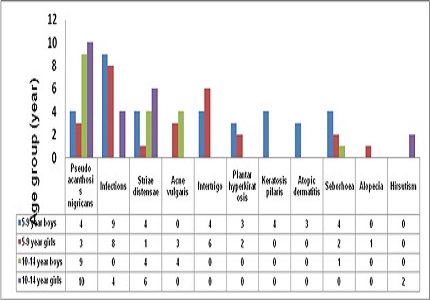Prospective clinical study of the skin markers in childhood obesity-an emerging pandemic
Abstract
Introduction: Obesity poses an alarming threat to the children in recent days due to poor lifestyle and improper dietary habits. These children are at higher risk of developing Coronary artery diseases, Hypertension, Diabetes mellitus in their early thirties and emerge as an important public health problem. Childhood obesity manifests with a wide array of dermatological changes. In this study we analyzed the dermatological manifestations in the obese and overweight children in the age range of 5-14 years.
Methods: All the children taken into the study were either obese or overweight as per WHO criteria of BMI according to the height and weight. Triceps skin fold thickness and waist circumference of these children were also taken for confirmation of obesity. Skin manifestations in these children were diagnosed by the dermatologists and plotted in graph.
Results: Total 76 children were taken into the study out of which Acanthosis nigricans is the most common manifestation in the age group of 10-14 years and infections are most common in the age group of 5-9 years.
Conclusion: The skin manifestations are the markers of chronic obesity in childhood having negative impact on the quality of life and imparting low self esteem among the peer group.
Downloads
References
2. HimesJH,Dietz WH..Guidelines for overweight in adolescent preventive services: recommendations from an expert committee. The Expert Committee on Clinical Guidelines for Overweight in Adolescent Preventive Services..Am J ClinNutr. 1994 Feb;59(2):307-16.
3. Dehghan M, Akhtar-Danesh N, Merchant AT.Childhood obesity, prevalence and prevention. Nutr J. 2005 Sep 2;4:24. [PubMed]
4. Burns T. Rook's Textbook of Dermatology.8thed.Wiley, New Jersey.2010
5. Mirmirani P, Carpenter DM. Skin disorders associated with obesity in children and adolescents: a population-based study. PediatrDermatol. 2014 Mar-Apr;31(2):183-90. doi: 10.1111/pde.12271. Epub 2013 Dec 13. [PubMed]
6. G Hidalgo L.Dermatological complications of obesity. Am J ClinDermatol. 2002;3(7):497-506. [PubMed]
7. Divyashree RA, Naveen KN, Pai VV, Athanikar SB, Gupta G.Cutaneous manifestations of obesity among dermatology patients in a tertiary care center. Indian J DermatolVenereolLeprol. 2014 May-Jun;80(3):278. doi: 10.4103/0378-6323.132270. [PubMed]
8. Boza JC, Trindade EN, Peruzzo J, Sachett L, Rech L, Cestari TF. Skin manifestations of obesity: a comparative study.J EurAcadDermatolVenereol. 2012 Oct;26(10):1220-3. doi: 10.1111/j.1468-3083.2011.04265.x. Epub 2011 Sep 20. [PubMed]
9. Al-Saeed WY, Al-Dawood KM, Bukhari IA, Bahnassy A. Dermatoses in obese female schoolchildren in the Al-khobar area, eastern saudiarabia.J Family Community Med. 2006 May;13(2):65-9. [PubMed]
10. Winkleby MA, Taylor CB, Jatulis D, Fortmann SP The long-term effects of a cardiovascular disease prevention trial: the Stanford Five-City ProjectAm J Public Health. 1996 Dec;86(12):1773-9. [PubMed]

Copyright (c) 2016 Author (s). Published by Siddharth Health Research and Social Welfare Society

This work is licensed under a Creative Commons Attribution 4.0 International License.


 OAI - Open Archives Initiative
OAI - Open Archives Initiative


